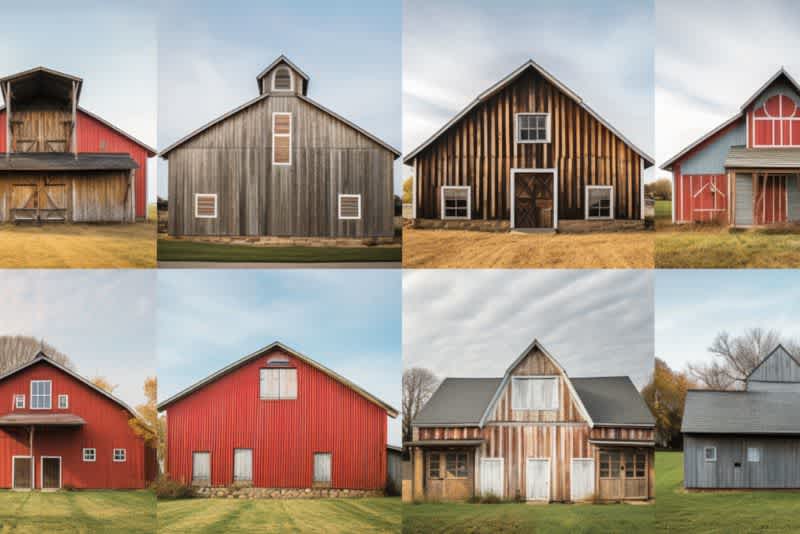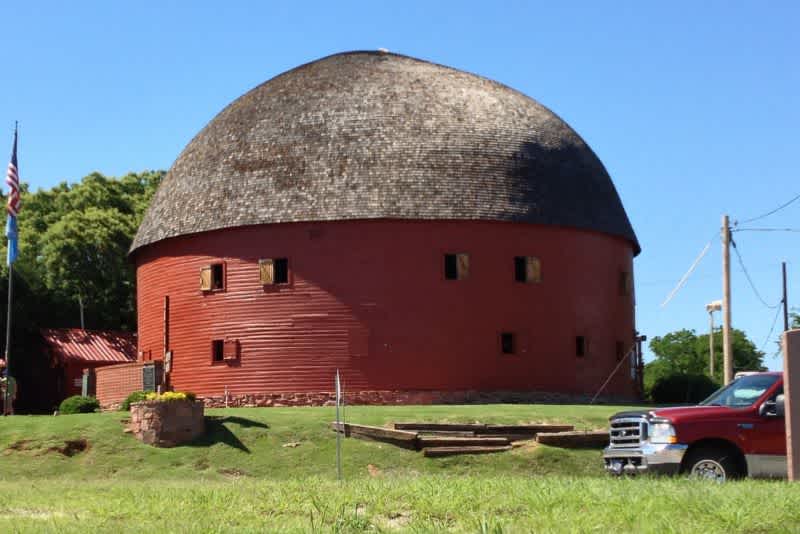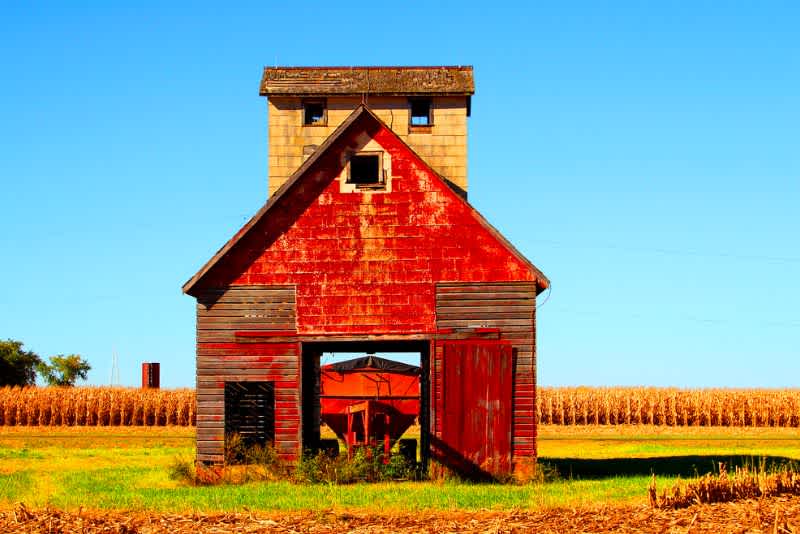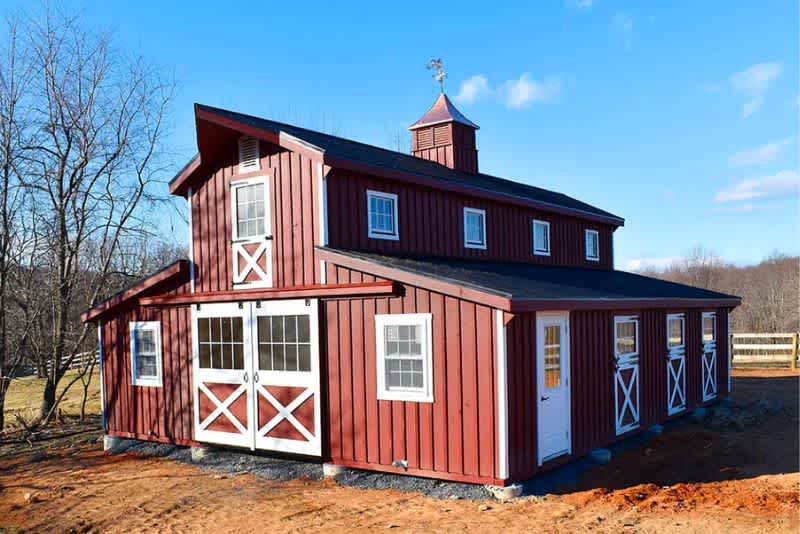10 Best Types of Barns & Barn Styles: From Rustic to Modern
Published: June 15, 2023

Barns have long been an iconic symbol of rural life, evoking images of the rustic charm often associated with a simpler time. While they've always served as functional spaces for agriculture and livestock, barns are now being repurposed to meet modern needs, from event venues to stylish homes.
So whether you're looking for inspiration to build your dream home or simply want to appreciate their timeless appeal, exploring the many different types of barn styles can be both fascinating and inspiring.
From traditional timber frames adorned with classic gambrel roofs, to sleek structures boasting minimalist lines and a more contemporary flair, there's a world of architectural diversity when it comes to these versatile buildings.
In this article, we'll dive into the best types of barns and barn styles that showcase the wide range of possibilities available today. Whether you're drawn toward charming rustic features or a more modern aesthetic, there's sure to be something here that inspires you.
What are the Best Types of Barns?
Here are the best types of barns:
Gambrel Roofed Barn
Shed Row Barn
Dutch Barn
Round Barn
English A-Framed Gable Barn
Corn Crib Barn
Peaked Prairie Barn
Bank Barn
Tobacco Barns
Monitor Barn
1. Gambrel Roofed Barn

The Gambrel barn is one of the most iconic and versatile barn styles. Its distinct Gambrel roof has a double slope on each side, this architectural design has been a popular choice for centuries for its aesthetics.
It offers the most amount of space utilization in its second-story loft. This increased area allows additional storage or living quarters.
However, the Gambrel is slightly more susceptible to collapsing due to its open design. As a result, there may be better options than this barn style for areas with high amounts of snow or rain.
2. Shed Row Barn

Next up: The Shed Row Barn.
One of the most attractive features of Shed Row barns is their space-saving benefits. They consist of stalls lined up along a single linear path.
These barns use limited land resources excellently while maintaining functionality and aesthetics. Since the stalls in this barn are in a line, they share walls, saving money and resources.
These barns are a popular choice for housing horses. The open stalls have great ventilation and natural light horses will surely enjoy.
So if you’re on a budget or don’t have a lot of space to work with, a Shed Row Barn is a great choice!
3. Dutch Barn

Dutch barns, known as New World Dutch barn, are the oldest and rarest barn type. Only a few hundred remain, dating back to the 18th and 19th centuries.
The unique Dutch features that set this barn style apart include its broad gable roof, which often extends lower than other barn types, providing ample space and protection from harsh weather conditions. They offer the most cubic feet of storage, making this worth the investment.
Like cathedrals, these barns are characterized by their large central columned aisle flanked on either side by smaller bays for storing hay or housing livestock. The structural support system within the barn has intricate joinery techniques making them very strong and durable.
4. Round Barn

Round barns have been present in American architecture since the 18th century, with roots tracing back to Europe.
The circular design of these barns not only makes them aesthetically appealing but also provides practical benefits such as increased structural stability and efficient use of space for storage or livestock.
The lack of corners within a round barn allows for better air circulation, reducing excess moisture that can lead to mold growth and rotting wood. Additionally, their curved walls help distribute wind pressure evenly throughout the building, making them less prone to storm damage compared to traditional rectangular structures.
5. English A-Framed Gable Barn

Gable barns are known for its steeply pitched roof, which provides several key advantages.
The A-frame structure allows for optimal interior space utilization (you can build a second floor). It easily sheds heavy snowfalls while maintaining its structural integrity under high wind pressure.
This gabled functionality also promotes effective ventilation and drainage, ensuring that livestock and stored crops stay dry and healthy throughout fluctuating weather conditions.
6. Corn Crib Barn

Rustic corn crib barns are a type of agricultural building traditionally used to store and dry corn (maize) after harvest.
It typically consists of a wooden structure with slatted walls to allow air to circulate and prevent moisture from building up. This allows the corn to dry naturally, which helps prevent mold and rot. It also helps keep rodents and other pests away from the stored corn.
Corn crib barns were common in rural areas of North America, especially in the Midwest, where corn is a major crop. While they are less common today, some farmers still use them to store and dry corn, and they are also sometimes repurposed as decorative or functional buildings for other uses, such as housing livestock or storing firewood.
7. Peaked Prairie Barn

A prairie barn is a type of agricultural building that was popular during the settlement of the American West in the 19th century.
These barns, also known as "Western barns," were typically constructed of wood and often painted a classic red color. They are characterized by their steeply pitched roofs that nearly reach the ground, and their large construction to store large amounts of hay, grain, and other agricultural products for large herds of cattle.
Prairie barns are similar to Dutch barns in that they have a central hallway with stable stalls in aisles. They were often equipped with sliding doors or large double doors that could be opened to allow for easy loading and unloading of materials.
Today, many prairie barns have fallen into disrepair or have been replaced by more modern agricultural buildings such as Gambrel barns which provide even more storage space. However, some have been preserved as historic structures or repurposed for other uses.
8. Bank Barn

Popular in the 19th century, bank barns are known for their two-level design. Often situated on hills or banks, these two levels can be accessed from the top or bottom of the hill.
There are two different types of bank barns in the United States:
Pennsylvania Bank Barn (the upper floor for hay storage with a stable on the bottom)
New England Bank Barn (the barn doors on the gable end with cows on the main level)
A deep dive into bank barn history reveals that this architectural gem was first introduced to America by German immigrants. The ingenious construction not only provided efficient storage solutions but also offered sheltered spaces for livestock on lower levels during harsh winter months.
So if your farmland has a lot of hills, consider a bank barn.
9. Tobacco Barns

Tobacco barns were once an essential step in the tobacco curing process. However, these barns are quickly disappearing as U.S. states such as Maryland actively discourage tobacco farming.
Characterized by their tall, narrow structure with slatted sides, these barns allow proper airflow needed for drying out the tobacco leaves. The design is typically characterized by some ventilation system and tiered poles that support rows of hung or speared tobacco stalks during the curing process.
Though not as common today due to changes in agricultural practices and technology advancements, traditional tobacco barns continue to be admired for their unique aesthetic appeal and connection to past agrarian roots.
10. Monitor Barn

One of the most iconic and versatile barn styles is the monitor barn. With its raised center aisle and double pitched roof running parallel with the main roof, this style has been a staple in agricultural architecture.
The benefits of monitor barns are numerous, including efficient use of space, improved ventilation, and natural light infiltration from the upper windows.
Modern adaptations have only increased the appeal of monitor barns. Today's designs often incorporate eco-friendly materials and energy-efficient technologies while preserving their traditional charm.
Which barn was your favorite?
Selecting the perfect barn style is a fusion of climate, purpose, and personal preferences.
Regardless, it's fascinating to learn about the different barn styles to understand these structures' incredible diversity and adaptability.
As we continue to innovate and evolve in design and technology, it's exciting to imagine how our modern interpretations of these classic styles will shape the landscape of rural architecture for generations to come.
Frequently Asked Questions
What is a traditional barn?
A traditional barn is an agricultural building used to house livestock and store crops and equipment. They typically feature a rectangular or square shape, a gable roof, and large doors for easy access.
Traditional barns were often constructed using local materials such as wood or stone and designed to withstand the weather and conditions of the local climate. They may also feature traditional architectural elements.
What is the cheapest style of barn to build?
Pole barns are the cheapest styles of barns to build. Pole barns use wooden poles for support and have steel or wood siding walls.
The cost of building a barn will depend on various factors, including size, materials used, and location.
What architectural style are barns?
Barns are typically considered to be functional rather than purely decorative structures, and as such, they do not belong to a specific architectural style.
However, some barns reflect a Gothic Greek Revival style with their steeply pitched roofs which was a popular style in the 19th century. Meanwhile, other barns have more classical styles characterized by symmetry and rectangular windows.
What style is a barn?
Barns don’t belong to a specific architectural style. However, barns often have common design features, such as a rectangular or square shape, a gable roof, and large doors for livestock or equipment access.
What is a barn style called?
A “barn style” can be described as “rustic,” but depending on the design, style, and construction they can have different names.
Keep track of all your cattle with the #1 Cattle Management Software
Try out Ranchr today for free